For the last five years, the City of Reykjavík has been waging a war. For a country without a military, this may seem curious, but this isn’t exactly a war involving soldiers. It’s not a war on drugs nor is it a war on homelessness, poverty or any other common social ill.
It’s a war on graffiti.
And some say, perhaps rightfully so. In 2008, the City of Reykjavík reported that 42,000 square metres of public space were plastered with characters and figures, scrawled with writing and letters and branded with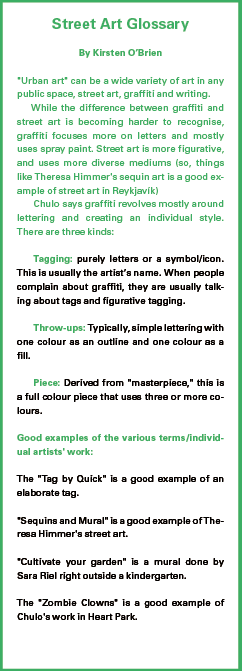 tags, nicknames and logos. Due largely to a harsh crackdown by the city, the amount of graffiti seen on the streets as of December 2012 has been reduced by nearly half, to 22,000 square metres. And while it’s true that some of the work may have been done by frustrated teenagers with nothing better to do, beloved public spaces such as Hjartagar›urinn (“The Heart Park”) were also born out of this explosion of colour, creativity and subversive independence.
tags, nicknames and logos. Due largely to a harsh crackdown by the city, the amount of graffiti seen on the streets as of December 2012 has been reduced by nearly half, to 22,000 square metres. And while it’s true that some of the work may have been done by frustrated teenagers with nothing better to do, beloved public spaces such as Hjartagar›urinn (“The Heart Park”) were also born out of this explosion of colour, creativity and subversive independence.
As some pieces of graffiti have become fixtures of the city and even legitimate tourist attractions, the question now has become not so much how to wipe out graffiti altogether, but how it can exist in a way that keeps the city, the public and the artists happy. It’s an issue at the intersection of questions about public space, legality and a complicated art form.
Meet the artists
Given the kaleidoscope of styles, characters, colours and signatures that can be seen in the city centre, it may come as a surprise that only a handful of individuals are responsible for the bulk of it.
One of them is Sara Riel, who sits across from me at her cosy home on Njálsgata. As a Bon Iver record plays quietly in the background, she tells me over coffee that she tried to do things the legal way at first.
However, after the City rejected her applications for funding, she bypassed the bureaucracy and went directly to property owners for permission to use their property for her art.
“All my work is completely financed and produced and made by me, with a lot of help from my friends. I usually had permission—but not really support—from property owners, most of whom have been rather nice about the whole thing. They’ll usually tell me, ‘we allow you to do your shit, but we won’t support you financially.’”
Sara is an Icelandic, Berlin-educated artist living and working in Reykjavík. Between puffs of a hand rolled cigarette, she details her experiences learning the ways of street art in Berlin before she moved back to Reykjavík, which she now considers her home as well as her canvas.
“I got into graffiti and street scene when I was in Berlin, and I’ve done my share of illegal tagging,” she says. “That’s kind of my origin, how it all began.”
Even though she was in a city 2,300 kilometres away, she orchestrated a gathering of eight Berlin-based international artists to come and paint in Reykjavík in 2005. The only remaining of their murals is located on the back of Mál og Menning on Laugavegur, a collection of towering cartoon-ish monkey characters.
As her murals have not been painted over, even though they are technically illegal, Sara has made a somewhat contentious peace with city officials. “In a way I have gotten support from them because they don’t take my work down and they don’t really bother me,” she says, a cigarette dangling between her fingers.
Her current project is a series called The Kingdoms, which features huge murals representing the various natural kingdoms. They are visible all over the city, from the magical mushroom on Hverfisgata to the phoenix on Nýlendugata.
Sara compares the series to an art installation in a museum, and she makes a clear distinction between her work and the quickly scrawled squiggles so many often associate with graffiti. “It’s more like really big paintings that happen to be on the streets, which form the museum space. It’s not spontaneous or an instant action, like I used to work; it’s more thought out, almost like an art show.”
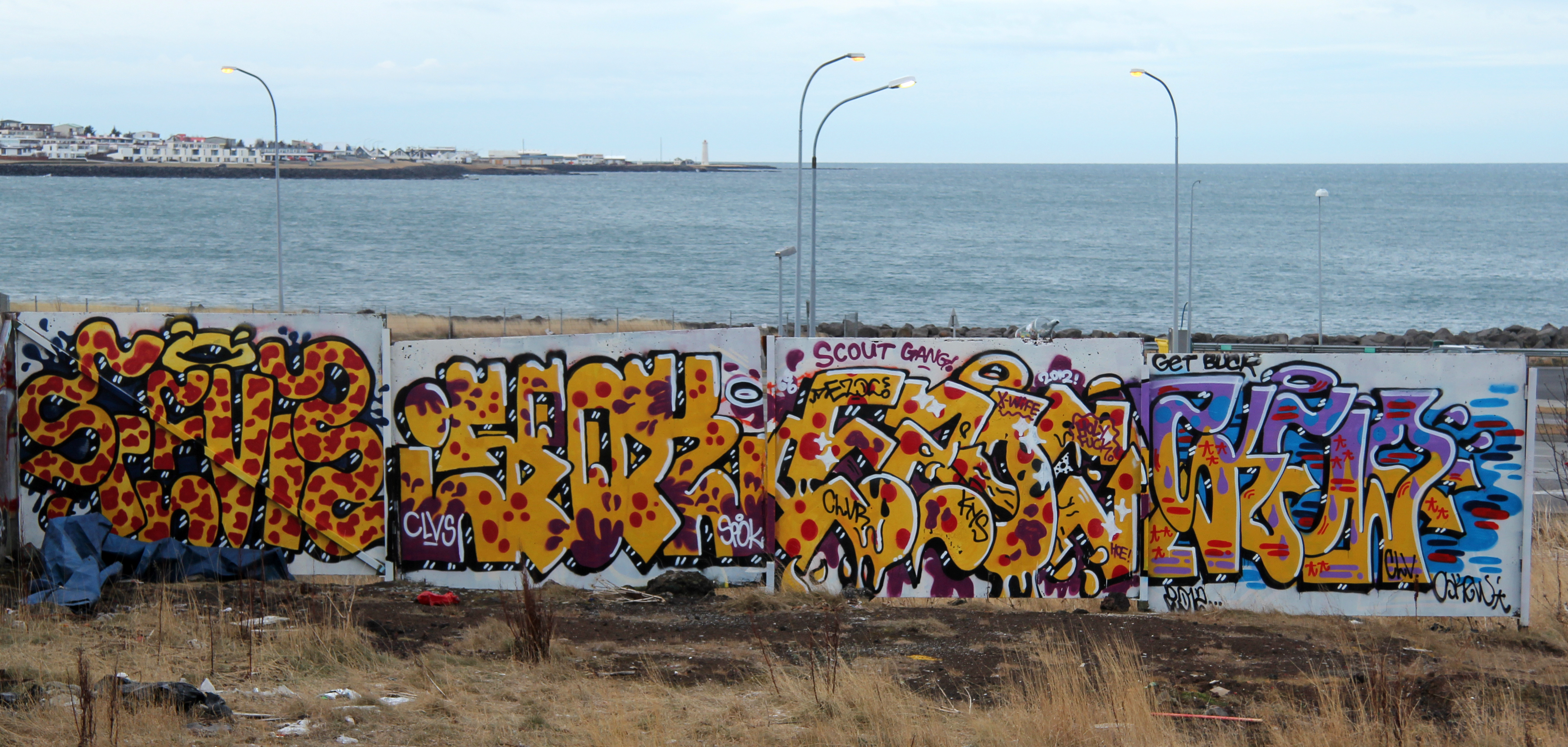
Cracking down
Prior to 2006, Sara says the City had a lax attitude about street art and graffiti. Although graffiti was illegal, she says police were lenient and didn’t often fine taggers or paint over works. As more and more people entered the scene and the internet allowed people to rapidly share and see designs from around the world, tagging and graffiti exploded, and the City adopted a zero-tolerance policy toward any and all street art, modelled after a similar stance adopted by some cities in Sweden and Finland.
“They went quite insane with this zero tolerance stuff. They spent an immense amount of money on it,” says Chulo, a fellow artist who walked in only moments earlier and enters the conversation without skipping a beat. Sara introduces Chulo (which is Spanish for ‘pimp’) as the “King” of Hjartagarðurinn because he is responsible for much of the characters in the community space. He is deeply involved in the scene, and later tells me that he has been documenting graffiti in Reykjavík for a book he plans to publish.
Like Sara, he begins to hand roll himself a cigarette. He was born in Iceland, but lived in Spain for several years as a child. He has been painting since 1996. His colourful and sometimes creepy characters loom large on the walls of Hjartagarðurinn, and although those remain standing, many of his creations were white-washed away when the city began its massive graffiti cleanse.
“It was such a naïve thing. This zero tolerance thing hasn’t worked anywhere,” he continues. “How are we going to be the first country in the world to eradicate graffiti?”
In 2008 alone, the city spent 159 million ISK cleaning up graffiti on road signs, fences, city buildings, tunnels, bridges and playgrounds. Of that amount, 50 million ISK went specifically into the city’s “Hrein borg,” (“Clean City”) campaign to catalogue and document exactly how much graffiti was scrawled across the city.
Although the city has relaxed since then, another $55 million ISK went to clean-up efforts in 2012. What’s more, according to reports by the national broadcasting service RÚV, the city continues to spend 3 million ISK per month cleaning up graffiti.
Changing attitudes
While the artists may say their work livens up the city, there is a difference between “livening up” and total saturation. Gu›mundur Vignir Óskarsson, a project manager for the City of Reykjavík, said there was backlash from both residents and city officials alike when graffiti and tags began to seemingly overtake the city.
“It was chaos,” he says. “In 2008, the central Reykjavík was like a garbage town.”
Since 2008, however, Guðmundur says the city has been slowly forging a link to the artists themselves. He explains that a change in city council members brought about a change in attitudes about graffiti, and that has shifted graffiti into a grey zone of being not quite all the way legal, but not quite all the way outlawed either. Guðmundur says that the city’s graffiti policy, as of December 2012, is that graffiti artists and taggers must obtain permission from property owners to paint, and property owners must obtain permission from the City Council of Reykjavík. Tagging in all circumstances is prohibited, and in many cases the City specifically removes graffiti from public schools, street tunnels, bridges, benches, lampposts and traffic signs. Chances are if it’s on city property, it’s not going to last long.
In some cases, neighbouring towns have instated policies that give artists legal places to paint. While the City of Reykjavík repaints the pedestrian underpass beneath Miklabraut up to twice a week, fifteen minutes south of Reykjavík, city officials in Hafnarfjörður allow artists and graffiti enthusiasts to apply to paint in five underpasses and tunnels throughout the city. Designated spots like these can actually help contain graffiti, Chulo says, because it gives young artists a space to practice. If young people are encouraged to treat graffiti as an art form, they might be less inclined to vandalise city property with thoughtless tags.

“The problem with graffiti is that the City made it a problem. When I was growing up we had these places to paint. And everyone would meet up there and everyone was into quality, trying to get better and develop,” Chulo says. “As they shut down all these places, we lost the connection between the older and younger generations, and now instead of competing with style, people compete with space, and the younger generations don’t develop as rapidly. They’ve grown up this way, and they’ve never had a place to practice, so this is all they know how to do.”
Guðmundur says Reykjavík may not be ready for that. He says that although the City’s policy is still in flux and city officials are working with graffiti artists and taggers to establish a mutually agreeable policy, painting in tunnels is strictly prohibited. To allow that would be a “big step,” he says, explaining that painting in regulated places may open the floodgates to painting in unregulated places, which results in more clean up costs. “If you allow it to spread, you will get a lot of smaller taggers and this will have a snowball effect, meaning more money to clean up the bad tags.”
Get’em while they’re young
With so much commotion and conversation surrounding legality, public space and what exactly can be considered “art,” one thing sometimes gets lost: the pieces themselves.
Amidst a haze of smoke and the gentle, steady noise of Bon Iver, both Sara and Chulo agree that when it comes to creating a piece, each decision is deliberate. They take into account a number of different factors, ranging from the placement of the piece and its audience to whether the piece will be viewed from up close or from far away, and what or how many colours should be used.
“It’s important to me that my pieces have a bold quality that will capture your eye. But within it, you’ll notice a deeper story or connection with the city,” Sara says. “All those things, for me as the artist, are a huge part of why I do a piece and where I’m doing it.”
She mentions a piece she made in collaboration with artist Daví› Örn Halldórsson called “Cultivate Your Garden,” located on Seljavegur 42. It’s a piece that features a collection of bright, alien-like flowers stretching horizontally across the side of grey wall. She notes that although it is hidden, it’s right next to a kindergarten, which is the piece’s main audience.
Chulo, who has been silently nodding in agreement, speaks up. “Gotta get’em while they’re young,” he says.
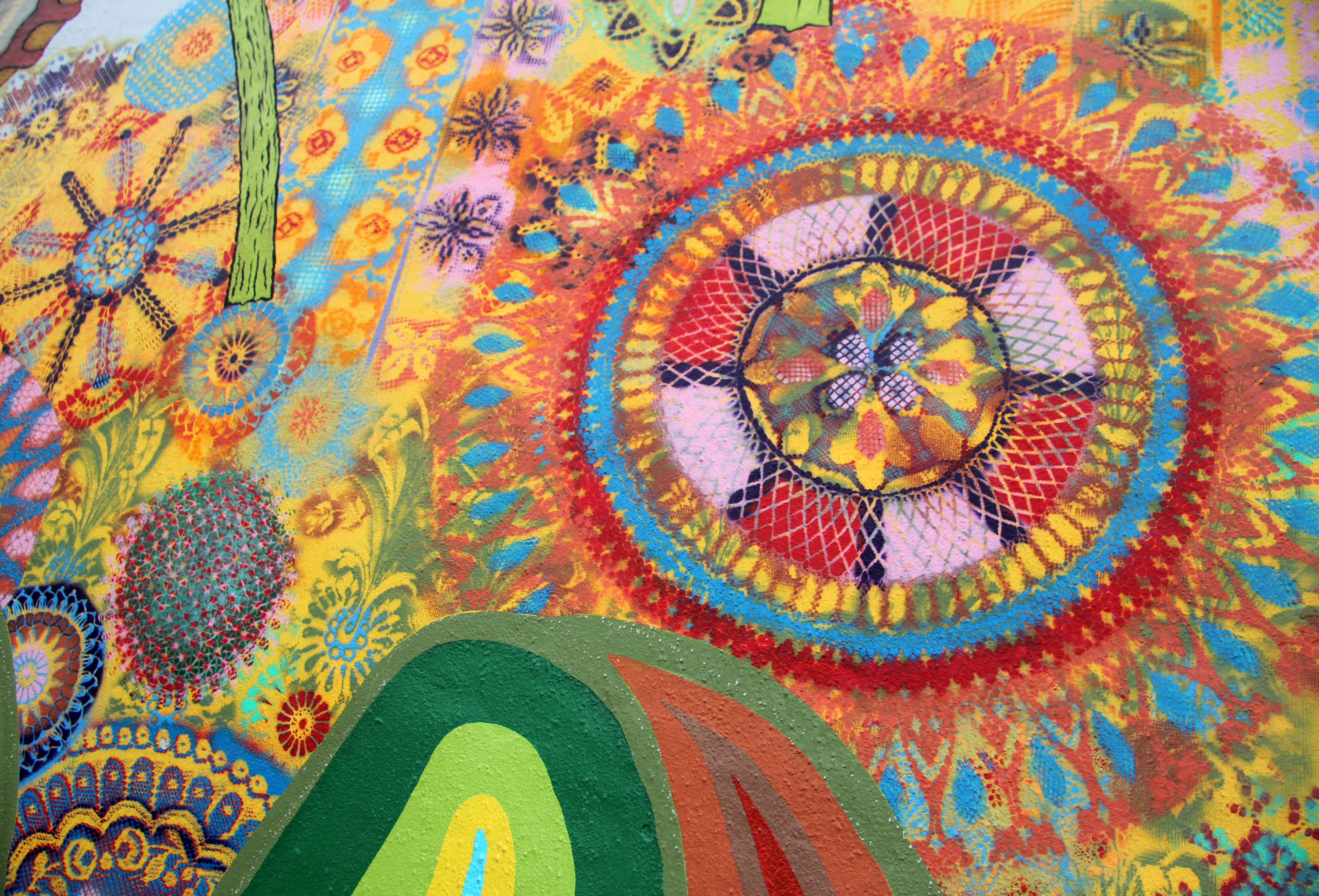
————-
Urban Canvasses: Örn Tönsberg
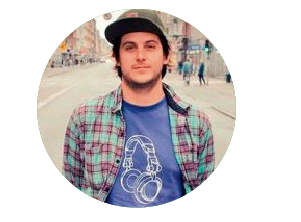
Where some see blank urban walls, Örn Tönsberg sees canvases. “I want to see a lively city,” he says. “That’s why I love doing these murals and meeting people and getting their stories.”
The work of the Reykjavík native and Muses member appears all over the city, from the nooks and crannies of city buildings to the walls of shops and boutiques and even the park Hjartagarðurinn.
Örn is trying to make graffiti more accessible as well. In May 2012, Örn and several fellow graffiti artists were awarded 6,300 euros from Youth in Action, an organisation that helps Europeans between the ages of 13– 30 to fund programmes directed at young people. He says the grant will allow him and other artists to create several large murals in the city, and eventually they will compile a print publication showcasing graffiti and other artwork.
Although Örn himself doesn’t have a formal background in art, he has been doing graffiti for the last decade. Upon returning to Reykjavík in 2011 after spending four years in Denmark, he started to receive more commissioned projects from downtown shops.
While the city formally had a “zero-tolerance” policy toward graffiti of any kind, he says the success and popularity of spaces like the Hjartagar›urinn (“The Heart Park”) are changing attitudes and perceptions about street art. He hopes to see more places in the city specifically designated for graffiti. “What you see at Hjartagarðurinn is really nice art, and it doesn’t poison the environment,” he says. “Something has been accomplished there, and I think the city will see that.”
At some point in the future he wants to take things a step further by opening a youth centre to host graffiti and music workshops, which would give young people more creative outlets.
“People tend to think graffiti is destructive, and everyone who turns to graffiti is like a troubled kid or something,” he says. “To some extent that’s right because those who seek to do graffiti are thrill seekers, but typically I’ve seen graffiti help people, especially kids who come from bad situations. It becomes the most positive thing about their life—they are at least doing art.”
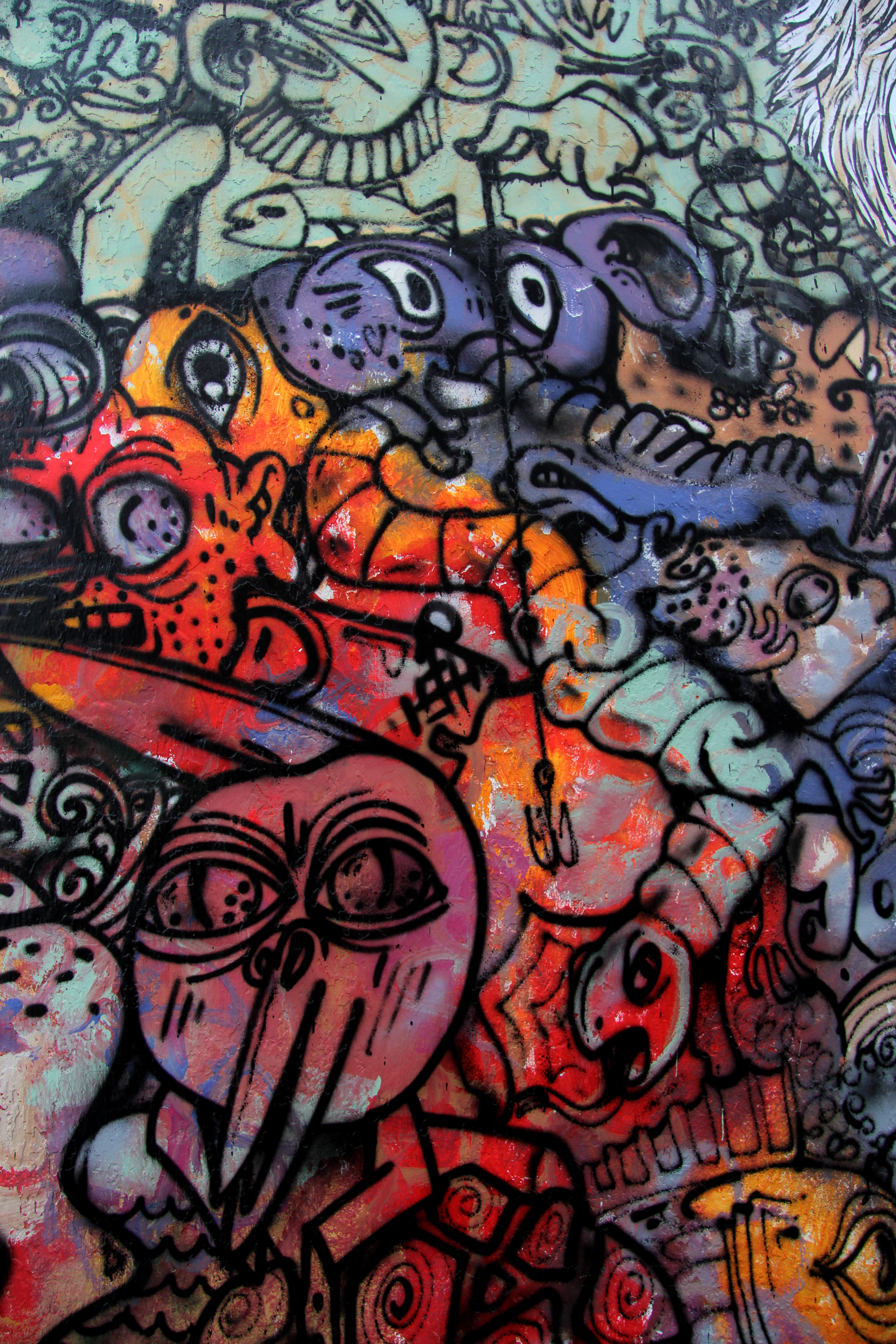
————
See Also:
The Writing On The Wall: Interview with Sara Riel
View Street art in Reykjavík in a larger map
Buy subscriptions, t-shirts and more from our shop right here!















